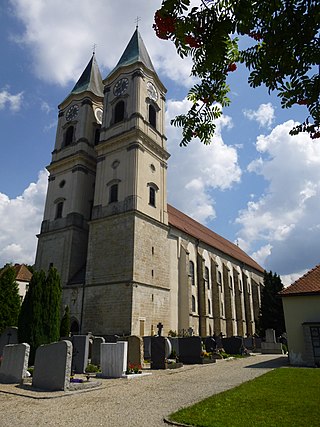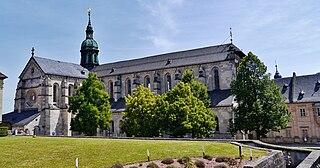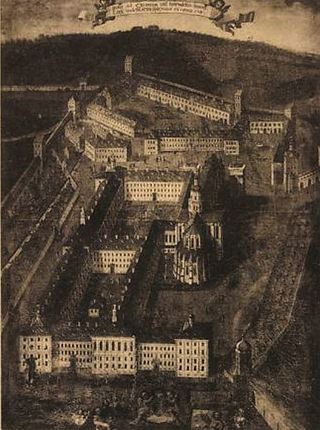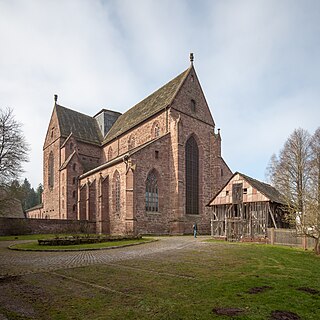Adam of Ebrach was a Cistercian monk and the first abbot of Ebrach Abbey in the area of Bamberg, Bavaria, Germany, and later the founding abbot of Langheim Abbey.

Maulbronn Monastery is a former Cistercian abbey and ecclesiastical state in the Holy Roman Empire located at Maulbronn, Baden-Württemberg. The monastery complex, one of the best-preserved in Europe, was named a UNESCO World Heritage Site in 1993.
Biburg Abbey was a Benedictine monastery located at Biburg in Bavaria, Germany.

Niederaltaich Abbey is a house of the Benedictine Order founded in 741, situated in the village of Niederalteich on the Danube in Bavaria.

Ebrach Abbey is a former Cistercian monastery in Ebrach in Oberfranken, Bavaria, Germany, and the site of a young offenders' institution.

Wilhering Abbey is a Cistercian monastery in Wilhering in Upper Austria, about 8 km (5 mi) from Linz. It was founded in 1146. The buildings, re-constructed in the 18th century, are known for their spectacular Rococo decoration.

Aldersbach Abbey is a former Cistercian monastery in the community of Aldersbach in the district of Passau in the valley of the Vils, Lower Bavaria, Germany.

The Imperial Abbey of Kaisersheim, was a Cistercian monastery in Kaisersheim, Bavaria, Germany.

Heilsbronn Abbey was a Cistercian monastery at Heilsbronn in the district of Ansbach in Middle Franconia, Bavaria, Germany. It was part of the Diocese of Eichstätt.

Banz Abbey, now known as Banz Castle, is a former Benedictine monastery, since 1978 a part of the town of Bad Staffelstein north of Bamberg, Bavaria, southern Germany.

Ebrach is a municipality with market rights in the Upper Franconian district of Bamberg and the seat of the Verwaltungsgemeinschaft of Ebrach.

Herrenalb Abbey is a former Cistercian monastery in the present Bad Herrenalb in Baden-Württemberg, Germany.
Leonhard Dientzenhofer was a German builder and architect from the well known Dientzenhofer family of architects.

Windberg Abbey is a Premonstratensian monastery in Windberg in Lower Bavaria, Germany.

Amelungsborn Abbey, also Amelunxborn Abbey, is a Lutheran monastery in Lower Saxony, Germany. It is located near Negenborn and Stadtoldendorf, in the Landkreis of Holzminden in the Weserbergland. It was the second oldest Cistercian foundation in Lower Saxony, Germany, after Walkenried Abbey. It survived the Reformation by becoming Lutheran, and with Loccum Abbey, also previously Cistercian, is one of the only two Lutheran monasteries in Germany with an uninterrupted tradition. The abbey church, St. Mary's, is also the parish church of the abbey's former estate villages Negenborn and Holenberg.

Michaelsberg Abbey or Michelsberg Abbey, also St. Michael's Abbey, Bamberg is a former Benedictine monastery in Bamberg in Bavaria, Germany. After its dissolution in 1803 the buildings were used for the almshouse Vereinigtes Katharinen- und Elisabethen-Spital, which is still there as a retirement home. The former abbey church remains in use as the Michaelskirche.

Sonnefeld Abbey is a former Cistercian nunnery in Sonnefeld in Bavaria, Germany. The former abbey church, or Klosterkirche, is now an Evangelical Lutheran parish church.

Buch Abbey, in German Kloster Buch, is a former Cistercian monastery near Leisnig in Saxony.

Maidbronn Abbey was a Cistercian nunnery in Maidbronn in the present municipality of Rimpar in Bavaria, Germany.

Fürstenzell Abbey is a former Cistercian abbey in Fürstenzell, in Bavaria, in the diocese of Passau. It was a daughter monastery of the Aldersbach monastery from the filiation of the Morimond primary abbey - Ebrach monastery.


















